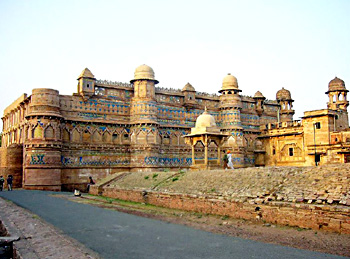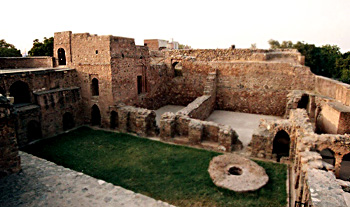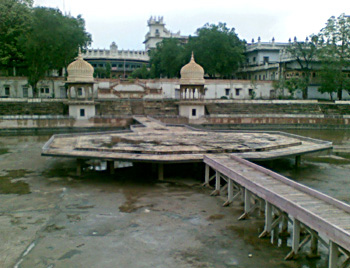 Leisure Tourism of Gwalior District contributes largely to the tourism industry of Madhya Pradesh. The places of interest in Gwalior evoke the artistic curiosity of an individual. The forts and palaces that are present in the district of Gwalior is an evidence of the pinnacle of excellence which architecture had reached in the early days. The Gwalior Fort, the Gujari Mahal and the Man Mandir Palace are some of the prominent tourist attractions of Gwalior.
Leisure Tourism of Gwalior District contributes largely to the tourism industry of Madhya Pradesh. The places of interest in Gwalior evoke the artistic curiosity of an individual. The forts and palaces that are present in the district of Gwalior is an evidence of the pinnacle of excellence which architecture had reached in the early days. The Gwalior Fort, the Gujari Mahal and the Man Mandir Palace are some of the prominent tourist attractions of Gwalior.
Gwalior Fort
Standing on a steep mass of sandstone, Gwalior Fort dominates the city and is its most significant monument. It has been the scene of momentous events, imprisonment, battles and jauhars. A steep road winds upwards to the fort, flanked by statues of the Jain tirthankaras, carved into the rock face. The magnificent outer walls of the fort still stand, two miles in length and 35 feet high, bearing witness to its reputation for being one of the most invincible forts of India. This imposing structure one of the greatest Mughal Emperors in India Babur to describe it as "the pearl amongst the fortresses of Hind".
Gujari Mahal
 The 15th century Gujari Mahal is a monument to the love of Raja Mansingh Tomar for his intrepid Gujar Queen, Mrignayani. The outer structure of Gujari Mahal has survived in an almost total state of preservation; the interior has been converted into Archaeological Museum housing rare antiquities, some of them dating back to the 1st century A.D. Even though many of these have been defaced by the iconoclastic Mughals, their perfection of form has survived the ravages of time. Particularly worth seeing is the statue of Shalbhanjika from Gyraspur, the tree goddess, the epitome of perfection in miniature. The statue is kept in the custody of the museum`s curator, and can be seen on request.
The 15th century Gujari Mahal is a monument to the love of Raja Mansingh Tomar for his intrepid Gujar Queen, Mrignayani. The outer structure of Gujari Mahal has survived in an almost total state of preservation; the interior has been converted into Archaeological Museum housing rare antiquities, some of them dating back to the 1st century A.D. Even though many of these have been defaced by the iconoclastic Mughals, their perfection of form has survived the ravages of time. Particularly worth seeing is the statue of Shalbhanjika from Gyraspur, the tree goddess, the epitome of perfection in miniature. The statue is kept in the custody of the museum`s curator, and can be seen on request.
Man Mandir Palace
Man Mandir Palace was built between 1486 and 1517 by Raja Mansingh. The tiles that once adorned its exterior have not survived, but at the entrance, traces of these still remain. Within the palace the rooms stand bare, stripped of their former glory, testifying to the passing of the centuries. Vast chambers with fine stone screens were once the music halls, and behind these screens, the royal ladies would learn music from the great masters of the day. Below, circular dungeons housed the state prisoners of the Mughals. Emperor Aurangzeb had his brother, Murad imprisoned, and later executed here. Close by is Jauhar Pond, where in the Rajput tradition, the Ranis committed mass sati after their consorts had been defeated in battle. At Man Mandir Palace, a poignant ambience of those days of chivalry and heroism still lingers in the silent chambers. A superbly mounted Son-et-Lumiere here brings it all alive every evening.
Tomb of Ghaus Mohammad
 The sandstone mausoleum of the Afghan prince, Ghaus Mohammed, is also designed on early Mughal lines. Particularly exquisite are the screens which use the pierced stone technique as delicate as lace. It is on the way to Gwalior fort near Hazira from Railway Station.
The sandstone mausoleum of the Afghan prince, Ghaus Mohammed, is also designed on early Mughal lines. Particularly exquisite are the screens which use the pierced stone technique as delicate as lace. It is on the way to Gwalior fort near Hazira from Railway Station.
Gopachal Parvat
Gopachal Parvat is situated on the mountain Area at slopes of Gwalior Fort carries unique statue of Jain Tirthankars. The largest idol of Bhagwan Parshwanath on Lotus is the largest statue (in single stone piece) in the world, being 47 feet high and 30 feet in width. The Jain Tirthankars Statues are a species of architecture and a treasure of Old Indian heritage and culture.
Sarod Ghar
This Museum of Music has been set up in the old ancestral house of the legendary Ustad Hafiz Ali Khan. It houses ancient instruments of the great Indian masters of yesteryears. It also houses an impressive collection of photographs and documents.
Sarod Ghar is a unique institution devoted to promoting Indian classical music, heritage and culture. Through this `window` to the past, music lovers can gain a better understanding of the evolution and history of our classical music and a deeper perspective and insight into the context of the art as it exists today.
Jai Vilas
Jai Vilas is an Italianate structure which combines the Tuscan and Corinthian architectural modes. In fact it can be said that the Jai Vilas Palace is splendour in totality.
Thus it can be said that tourism in the Gwalior District is more or less centred towards the numerous historical heritages which the region possesses and the places of interest are able to quench the historical thirst of a traveller.



















